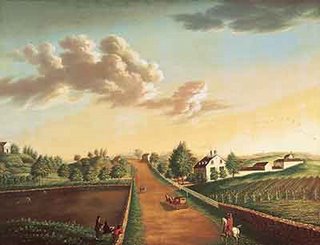 A new hedgerow in Abbey Fields, Kenilworth
A new hedgerow in Abbey Fields, KenilworthIn November 1795, George Washington wrote to his farm manager, William Pearce: “There is nothing which has relation to my farms, not even the Crops of grain, that I am so solicitous about as getting my fields enclosed with live fences, I cannot too often, nor too strongly inculcate this doctrine upon you... [For] at least 15 years have I been urging my managers to substitute live fences in lieu of dead ones, which, if continued upon the extensive scale my farms require, must exhaust all my timber...” Washington’s weekly correspondence with Pearce was filled with instructions on the cultivation of hedges. He told Pearce to gather the berries of white thorn and cedar, to germinate and transplant honey locust, and to set out rows of poplar and willow. He even loaned his manager a practical treatise on Hedges.
 A mature hedgerow (with gaps). Camp Farm, Kenilworth
A mature hedgerow (with gaps). Camp Farm, KenilworthHedgerows are one of the defining features of the English rural landscape. To the American landscape architect Andrew Jackson Downing, who visited Warwickshire in 1850, they represented “the chief difference between an English rural landscape” and the landscape of the rural United States. When he came upon a spot where a section of hedge had been destroyed, and a temporary rail fence erected, he found that “the whole thing was lowered at once to the harshness and rickety aspect of a farm at home.” For George Washington, and other enlightened American farmers in the late eighteenth century who wanted to enclose their fields with beautiful hedges, the challenge was to find a hedge plant that would flourish in the American environment. The most common English hedge plant, the hawthorn, didn’t fare well in America. Washington experimented with honey locust. Another possibility was “Newcastle thorn” (Crataegus crus-galli), which was native to the East Coast.
 Michele Felice Corné, "The Ezekiel Hersey Derby Farm" (1800). The farm before Derby's fateful discovery of a new hedge plant.
Michele Felice Corné, "The Ezekiel Hersey Derby Farm" (1800). The farm before Derby's fateful discovery of a new hedge plant.In about 1808, a gentleman farmer in Salem, Massachussets, Ezekiel Hersey Derby, happened to notice an unusual and flourishing thorn tree in the garden of Salem’s distinguished physician, Dr. Edward Holyoke. The tree produced plentiful berries, which appeared to germinate quickly and easily—unlike other more temperamental species of thorn commonly used in hedges. Derby asked Dr. Holyoke about the tree and learned that it was Rhamnus catharticus, or buckthorn, a species long cultivated for the purgative qualities of its berries and bark. Syrup of buckthorn, advised Eliza Smith in The Compleat Housewife (Williamsburg 1742), provided “a good purge.” But no one, until Ezekiel Derby saw it growing in Dr. Holyoke’s garden, had thought to try buckthorn in hedges.
Buckthorn, Derby found, created a virtually indestructible hedge. He was so pleased with the results of his experiment that he began to publicize it in the agricultural journals. In 1832, John Lowell, the secretary of the Massachussets Agricultural Society, wrote: “We are indebted wholly, and entirely, to the experiments of Ezekiel Hersey Derby, Esq., for the possession of a plant, the buckthorn (Rhamnus catharticus), which, from ten years’ trial seems to afford every desirable quality for a healthy, beautiful, and effectual hedge." By the 1840s, farmers in the prairie states, where timber for rail fences was scarce, learned about buckthorn from the agricultural journals and began to send back east for seeds. The editor of The United Agriculturalist in Chicago obligingly acquired a large supply from Connecticut that he made available to his subscribers.
 Buckthorn in a Minnesota woods.
Buckthorn in a Minnesota woods.To anyone in Minnesota who has walked through the woods in the late fall, this is a familiar sight. The qualities which Derby so admired in buckthorn, its easy propagation and indestructibility, have made it a plague on the native landscapes of Minnesota. The exotic buckthorn easily escaped from cultivation in hedges and invaded the woods and oak savanna, from which it is now nearly impossible to eradicate.


No comments:
Post a Comment